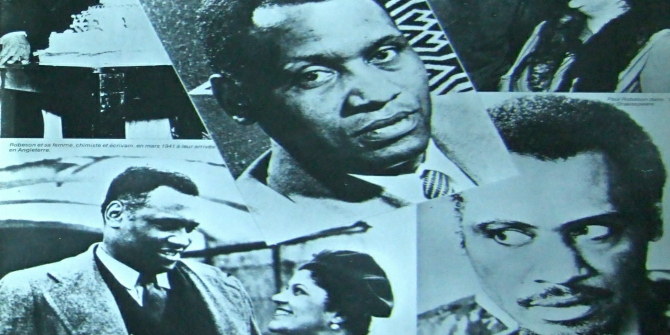Japanese animation is at the nexus of an international multimedia industry worth over $6.5 billion a year, linked to everything from manga to computer games, Pokémon and plushies. In this book, Jonathan Clements sets out to chronicle the production and reception history of anime, from a handful of hobbyists in the 1910s to the Oscar-winning Spirited Away and beyond. Casey Brienza finds this book to be a magisterial effort that will prove invaluable for scholars, particularly in the social sciences, who are interested in the political economy of anime production.
 Anime: A History. Jonathan Clements. BFI and Palgrave Macmillan. 2013.
Anime: A History. Jonathan Clements. BFI and Palgrave Macmillan. 2013.
In the Acknowledgements section which precedes the text of Anime: A History, author Jonathan Clements admits that he did not always take the advice of the consultants for the British Film Institute who peer-reviewed the book proposal and manuscript. He writes, “I have wilfully clung to several sources and concepts derived from history in order to elucidate what I regard as common errors of practice in the film studies community. On occasion, this may appear like I am reinventing a few wheels, but I strongly feel that some writers on anime could do with a reminder of how the cart actually rolls.” As it turns out, the decidedly defensive tone of this preliminary declaration is an early indication of just how unexpected—and to certain constituencies, at least, controversial—a book on the history of Japanese animation, colloquially known as “anime,” this will be.
But what exactly does one expect from anyone who has as eclectic an anime-related CV as Clements? Well, despite dabbling in “conventional” academic writing on the subject since completing an MA dissertation at the University of Stirling in 1995, he has built his reputation in and around the media industries primarily as a scriptwriter, freelance translator, and columnist for the East Asian popular culture magazine Neo. He has also co-authored popular, fan-friendly books such as The Anime Encyclopedia and The Erotic Anime Movie Guide with Helen McCarthy, and his most recent contribution in this vein, published in 2009, is the sarcastic and dishy Schoolgirl Milky Crisis: Adventures in the Anime and Manga Trade. It would therefore stand to reason that Anime: A History is Clements with some combination of his industry insider and popular cultural commentator hats on.
Anyone who is expecting that sort of book would be well-advised to give this one a miss. This is a scholarly monograph based upon Clements’ PhD thesis, and it has a fifteen page list of references and nary a gossipy anecdote. However, it is not the sort of book with the BFI’s imprimatur that one might expect, either. Clements is not interested in anime as a set of texts or tropes; he is interested, rather, in how anime as a cultural object has been understood across time, and why certain creators, titles, and screenings become historically “significant.” The title Anime: A History is in reality a bit of a misnomer; it is less history than historiography—a study of how the history of anime has already been told.
Unfortunately, no one has ever before published a book on the history of anime in English, so there are certainly tensions between Clements’ scholarly and commercial aims—it’s awfully hard to clarify, critique, or dispose of prevailing popular views about anime history when those are not exactly easy to come by in the first place! As such, the book is arranged in a conservative chronological order, starting with the earliest evidence of animation in Japan at the dawn of the 20th century and ending with a detailed explication of new digital technologies at the dawn of the 21st. Along the way, it explores topics such as labor conditions and disputes in early anime studios, the economic importance of merchandising and the “media mix” of comics, anime, toys, and other branded merchandise, the impact of VHS and other recording/distribution technologies, and anime as a global export. In practice, it might be better understood as a history (or historiography) of the anime industry than of anime in any other broad sense.

Nevertheless, the great strength of this book is the scale of its ambition. Clements’ wealth of experience and expertise in the subject has resulted in a work that reads less like first monograph revised from a PhD thesis and more like the logical culmination of a long career in and around the anime field. I was hugely impressed by the level of detail, particularly the pages devoted to early examples of animation in Japan which can be traced solely through information about their exhibition and even then, precisely what was actually screened remains controversial. He also gives important attention to rather unconventional animated products such as instructional videos (now lost) produced for the Japanese military during the Second World War and to animated advertisements produced for early Japanese television.
That level of detail, combined with staunch academic position-takings regarding the unreliability of memory and the arbitrariness of narrative, is also arguably its greatest weakness. The historical importance of, say, the so-called God of Manga Osamu Tezuka and his anime studio Mushi Pro may be a matter of fan lore, but it’s hard to imagine that a large contingent of anime fans will take much pleasure in a book that does not even make it to Tezuka till chapter six of a total of ten. The layperson may likewise feel thwarted by the ways in which names, events, and series surface and resurface throughout the text yet are not explicitly linked, their significance to the proverbial larger story ever up for grabs. And I was likewise troubled by the way Clements makes easy industry prognostications about anime’s future in the final chapter; they read more like rehearsal of industry common wisdom than the rigorous historiographical analysis elsewhere.
All in all, though, Anime: A History is a magisterial effort and will undoubtedly prove invaluable for scholars, particularly in the social sciences, who are interested in the political economy of anime production. Indeed, while Clements may profess to be skeptical of history as a narrative project, his book may well shape the discourse on the subject for years, if not decades, to come.
This review originally appeared at the LSE Review of Books.
Please read our comments policy before commenting.
Note: This article gives the views of the authors, and not the position of USApp– American Politics and Policy, nor of the London School of Economics.
Shortened URL for this post: http://bit.ly/1gYdD9m
——————————————–
Casey Brienza – City University
Casey Brienza is a sociologist and Lecturer in Publishing and Digital Media at City University London’s Department of Culture and Creative Industries. She holds a first degree from Mount Holyoke College, an MA in Media, Culture, and Communication from New York University, and a PhD in Sociology from the University of Cambridge. Her doctoral thesis, titled ‘Domesticating Manga: Japanese Comics, American Publishing, and the Transnational Production of Culture,’ and is currently being revised into a book manuscript. Casey also has refereed articles in print or forthcoming in International Journal of Cultural Policy, Journal of Popular Culture, Studies in Comics, and more. She may be reached through her website. Read more reviews by Casey.






